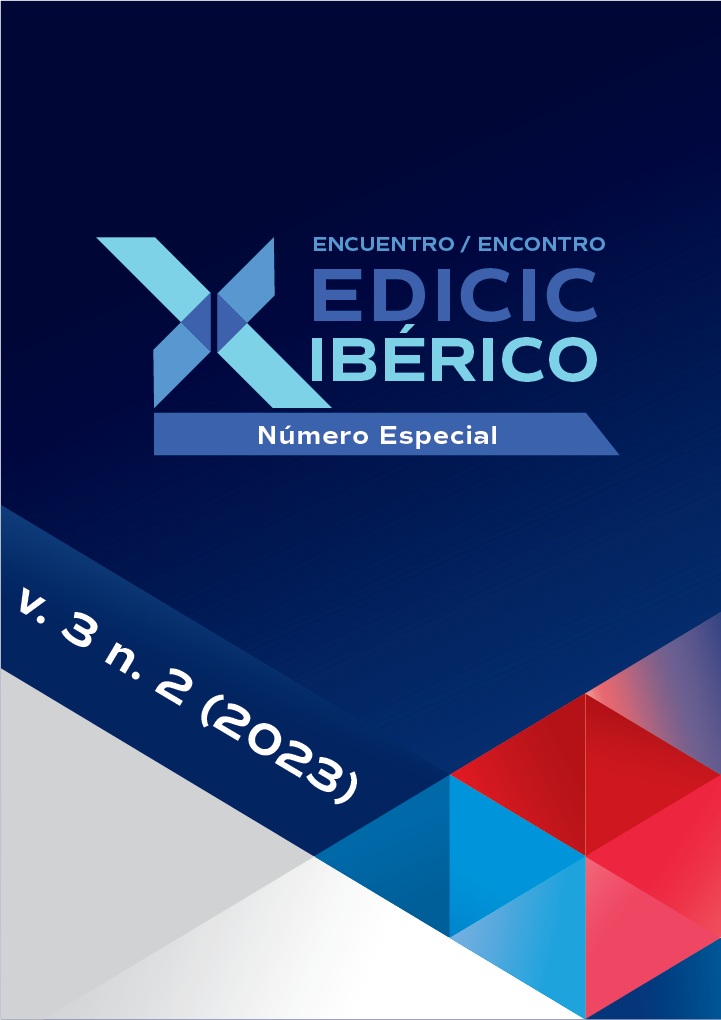Social machines in information science: a focus on Brazil
DOI:
https://doi.org/10.62758/re.v3i2.274Keywords:
Information Science, Social Machines, Technological Challenges, BRAPCI, MappingAbstract
The research field dedicated to social machines in Information Science continues to reveal itself as a fertile and constantly expanding territory. However, it is important to note that, so far, there is no universally accepted definition for the term "social machines" within the scientific community. This scenario demands a deeper understanding of how this concept has been explored in Information Science, a field that, by its nature, is closely linked to the process of dissemination and sharing of information in an increasingly digital contemporary context. As society becomes increasingly digital, the role of social machines in the contexts of access, representation, and dissemination of information assumes growing importance. But what exactly are social machines? These mechanisms can be conceptualized as spaces or systems driven by humans that play a fundamental role in the socialization of information, connecting diverse and distinct communities. This study focuses on analyzing how the theme of social machines has been discussed in the academic community of Information Science in Brazil. To conduct this research, a systematic literature mapping was carried out using the BRAPCI and Google Scholar databases as sources. Specific inclusion criteria were applied, limiting the search to scientific articles in Portuguese published between 2018 and 2023 that included the term "social machines" in their titles or abstracts. Furthermore, priority was given to selecting papers that employed descriptive methodologies and presented relevant results for the topic at hand. Initially, a total of 696 papers related to our research were identified. However, after a careful analysis and the application of selection criteria, only one paper was considered appropriate for our analysis. Surprisingly, this selected paper did not fully meet the objectives of our research, as it did not address aspects that substantially contributed to the development of an understanding of the theme within the field of Information Science. Instead, the chosen paper presented a historical approach, tracing the evolution of the concept of social machines in relation to Information Science. In this context, an important question arises: is Brazilian Information Science really exploring the dimensions of the social machines phenomenon? We argue that the field could significantly benefit from expanding its horizons and embracing more in-depth and comprehensive studies that explore the role of information in contemporary society, especially in the context of digital technologies. In summary, this study does not provide a definitive conclusion. Instead, it serves as a starting point for a broader and deeper analysis of Information Science as a contemporary field intrinsically linked to technological development in society. The challenge now is to explore social machines more widely and their relationship with Information Science in Brazil, thereby contributing to a more holistic and comprehensive understanding of this theme.
References
Araújo, C. A. Á. (2014). O que é Ciência da Informação?. Informação & Informação, 19(1), 01-30. DOI: https://doi.org/10.5433/1981-8920.2014v19n1p01
Araújo, C. A. Á., & Valentim, M. L. P. (2019). A Ciência da Informação no Brasil: mapeamento da pesquisa e cenário institucional. Bibliotecas. Anales de Investigación, 15(2), 232-259.
Bardin, L. (2011). Organização da análise. Análise de conteúdo. São Paulo: Edições, 70, 229.
Bauman, Z. (2003). A sociedade líquida. Folha de São Paulo, 19, 4-9.
BERNERS-LEE, Tim; FISCHETTI, Mark. Weaving the Web: the past and present and future of the World Wide Web by its inventor. (No Title), 1999.
Borko, H. (1968). Ciência da Informação: o que é isto. American Documentation, 19(1), 3-5. DOI: https://doi.org/10.1002/asi.5090190103
Burégio, V., Meira, S., & Rosa, N. (2013, May). Social machines: a unified paradigm to describe social web-oriented systems. In Proceedings of the 22nd international conference on World Wide Web (pp. 885-890). DOI: https://doi.org/10.1145/2487788.2488074
Castells, M. (2005). A sociedade em rede: do conhecimento à política. A sociedade em rede: do conhecimento à acção política, 17-30.
Silva, R. F. M. da, & de Arruda Burégio, V. A. (2018). Um Estudo de Mapeamento das Contribuições e Desafios de Pesquisa em Máquinas Sociais. Gestão. Org, 16(7), 245-257. DOI: https://doi.org/10.21714/1679-18272018v16Ed.p245-257
Dalton, B. (2013, May). Pseudonymity in social machines. In Proceedings of the 22nd International Conference on World Wide Web (pp. 897-900). DOI: https://doi.org/10.1145/2487788.2488076
de Gomez, M. N. G. (1993). A representação do conhecimento e o conhecimento da representação: algumas questões epistemológicas. Ciência da Informação, 22(3).
Fiore, Q., & McLuhan, M. (1967). The medium is the massage (Vol. 9). New York: Random House.
Henderson, J. C., & Venkatraman, H. (1999). Strategic alignment: Leveraging information technology for transforming organizations. IBM Systems Journal, 38(2.3), 472-484. DOI: https://doi.org/10.1147/SJ.1999.5387096
Hendler, J., & Berners-Lee, T. (2010). From the Semantic Web to social machines: A research challenge for AI on the World Wide Web. Artificial Intelligence, 174(2), 156-161. DOI: https://doi.org/10.1016/j.artint.2009.11.010
Jacobs, W. B., Walsh, G. S., & Miller, F. D. (2004). Neuronal survival and p73/p63/p53: a family affair. The Neuroscientist, 10(5), 443-455. DOI: https://doi.org/10.1177/1073858404263456
Jacsó, P. (2005). Google Scholar: the pros and the cons. Online Information Review, 29(2), 208-214. DOI: https://doi.org/10.1108/14684520510598066
JAPIASSU, H., & Marcondes, D. (1993). Dicionário básico de filosofia.[Sl].
Keen, P. G. W. (1993). Information technology and the management difference: a fusion map. IBM Systems Journal, 32(1), 17-39. DOI: https://doi.org/10.1147/sj.321.0017
Kitchenham, B., & Charters, S. (2007). Guidelines for performing systematic literature reviews in software engineering.
Lévy, P. (1999). Cibercultura. São Paulo: Editora 34.
Luftman, J. N., Lewis, P. R., & Oldach, S. H. (1993). Transforming the enterprise: The alignment of business and information technology strategies. IBM Systems Journal, 32(1), 198-221. DOI: https://doi.org/10.1147/sj.321.0198
Ortiz, R. (1994). Uma cultura internacional-popular. Mundialização e Cultura. São Paulo, Brasil: Brasiliense.
Petersen, K., Feldt, R., Mujtaba, S., & Mattsson, M. (2008, June). Systematic mapping studies in software engineering. In 12th International Conference on Evaluation and Assessment in Software Engineering (EASE) 12 (pp. 1-10). DOI: https://doi.org/10.14236/ewic/EASE2008.8
Pickler, M. E. V. (2007). Web Semântica: ontologias como ferramentas de representação do conhecimento. Perspectivas em Ciência da Informação, 12, 65-83. DOI: https://doi.org/10.1590/S1413-99362007000100006
Ramos, M. G. (1994). Modelos de comunicação e divulgação científicas-uma revisão de perspectivas. Ciência da Informação, 23(3).
Roush, W. (2005). Social machines: Computing means connecting. Technology Review-Manchester Nh-, 108(8), 44.
Santana, C. A., Lima, C. O., & Nunes, A. A. (2021). De Leibniz às máquinas sociais: uma visão histórica do surgimento dos agentes inteligentes de informação sob a ótica da ciência da informação. Perspectivas em Ciência da Informação, 26, 133-156. DOI: https://doi.org/10.1590/1981-5344/3554
Saracevic, T. (1996). Ciência da informação: origem, evolução e relações. Perspectivas em Ciência da Informação, 1(1).
Shadbolt, N. R., & Burton, A. M. (1990). Knowledge elicitation techniques: Some experimental results. Readings in Knowledge Acquisition, 21-33.
Shadbolt, N. R., Smith, D. A., Simperl, E., Van Kleek, M., Yang, Y., & Hall, W. (2013, May). Towards a classification framework for social machines. In Proceedings of the 22nd International Conference on World Wide Web (pp. 905-912). DOI: https://doi.org/10.1145/2487788.2488078
Souza, M. D., Izo Júnior, A., & Souza, R. R. (2019). Modelagem de tópicos: mapeamento científico do GT-8 do Enancib. 2019, 24(2). DOI: https://doi.org/10.51359/2448-0215.2018.242511
Weill, P. (1992). The relationship between investment in information technology and firm performance: A study of the valve manufacturing sector. Information Systems Research, 3(4), 307-333. DOI: https://doi.org/10.1287/isre.3.4.307
Downloads
Published
How to Cite
Issue
Section
License
Copyright (c) 2023 Revista EDICIC

This work is licensed under a Creative Commons Attribution 4.0 International License.
The Association holds the copyright of the texts it publishes and, therefore, adopts a Creative Commons License, CC BY 4.0 DEED Attribution 4.0 International (https://creativecommons.org/
You are free to:
- Share: copy and redistribute the material in any medium or format for any purpose, even commercially.
- Adapt: remix, transform, and build upon the material for any purpose, even commercially.






